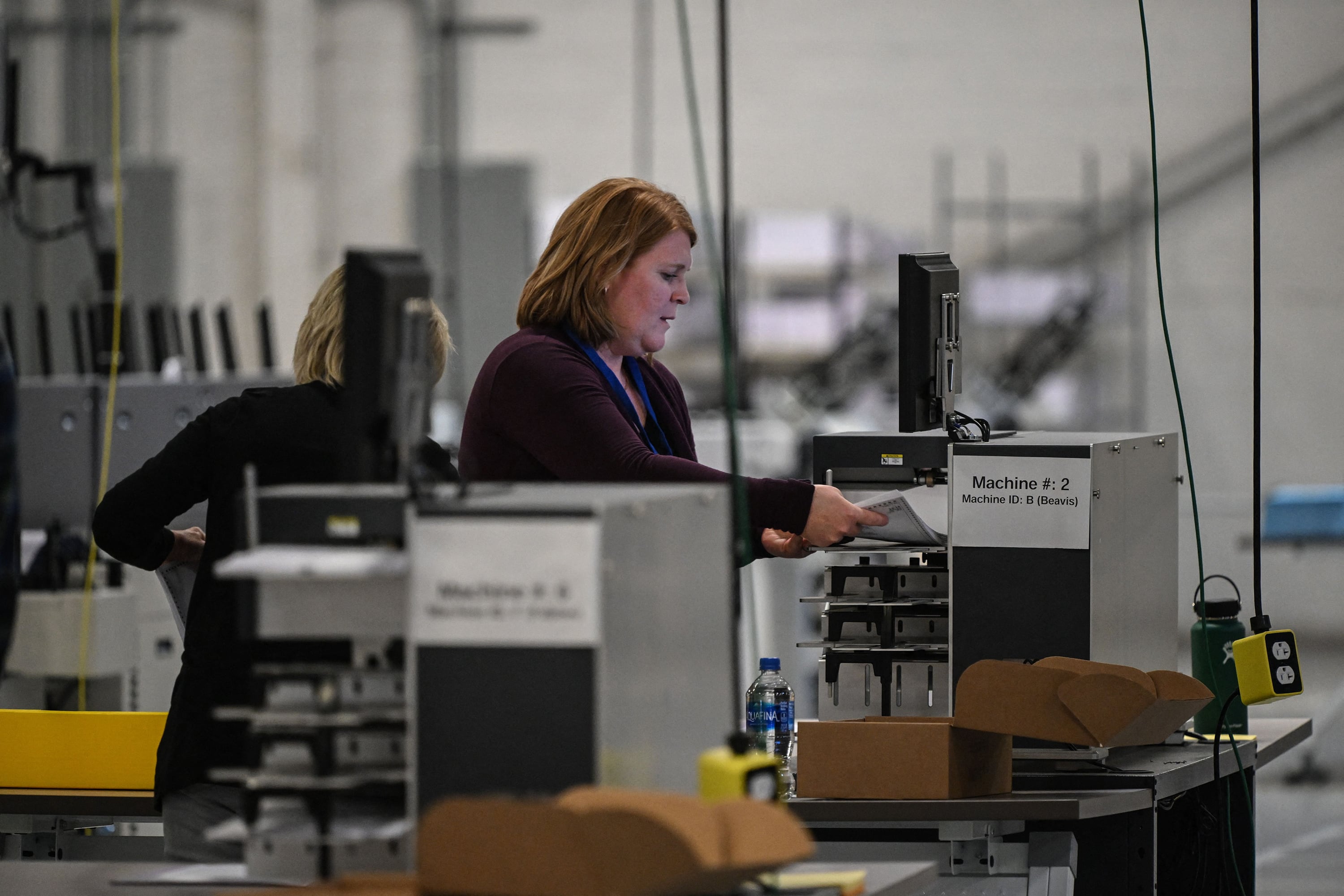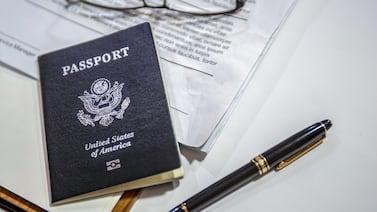Votebeat is a nonprofit news organization reporting on voting access and election administration across the U.S. Sign up for our free newsletters here.
During what is likely to be another contentious presidential election in Pennsylvania, you may hear contradictory, confusing, or downright false claims about voting machines.
Politicians in the past few elections have promoted fabricated claims about how they work or taken advantage of routine problems to cast doubt on their security and accuracy.
In Pennsylvania, all voting systems produce paper ballots that can be audited. This allows election officials to verify the accuracy of the outcome long after voting has concluded.
These systems are tested twice, once at the federal and once at the state level, before going into service. Before each election, each machine that will be used is tested again to ensure it works properly.
Despite these security measures, politicians have seized on human error or completely invented information to cast doubt on election results.
In November 2020, former President Donald Trump amplified false claims that Dominion Voting Systems machines switched 221,000 votes from himself to Joe Biden in Pennsylvania. He made numerous such claims as part of a larger, concerted effort to overturn the results of the presidential election.
Ahead of the 2024 election, Spotlight PA and Votebeat spoke with state officials about the status of Pennsylvania’s voting machines, how the devices are certified, and how counties select them.
The types of voting machines used in Pennsylvania
Following the 2016 presidential election, Green Party candidate Jill Stein sued Pennsylvania over its voting systems, claiming they were susceptible to hacking.
A 2018 settlement in that case forced all counties to purchase new machines that produce a “voter-verifiable paper ballot” that could be audited. Previously, some counties had used machines with touch screens that produce no paper ballot, devices known as direct recording equipment.
“This is the most important security feature that voting systems can have, is that there is a paper record of every single vote cast,” said Derek Tisler, an attorney with the Brennan Center for Justice’s Democracy Program who recently co-authored a report on how to secure the 2024 election.
“Having that paper means you don’t need to trust [technology] to get it right,” he said. “You can use voting machines to count the ballots and then check a sample of those paper ballots to make sure everything was working as it should.”
In Pennsylvania, counties make most election decisions. This includes what machines to purchase.
Verified Voting, a nonpartisan elections technology organization, tracks machines used nationwide. According to its database, 70% of Pennsylvania counties primarily have voters mark a paper ballot by hand, then they feed the ballots to a tabulator that scans, tallies, and stores the votes. The ballots are retained in a ballot box in case of audit or recount.
The other 30% use “ballot marking devices.” Those machines have voters make selections on a screen, then the device prints out a ballot with those selections. Many counties also offer this type of machine for voters with disabilities.
Pennsylvania uses voting machines from five companies: Clear Ballot, Dominion, ES&S, Hart InterCivic, and Unisyn. More than half of counties use ES&S machines.
The most popular system is the ES&S DS200, a tabulator that scans hand-marked paper ballots, according to Verified Voting.
Despite the security and redundancies in place, minor malfunctions with Pennsylvania’s voting equipment or administration happen. These often garner outsized scrutiny due to the state’s importance in national elections.
Philadelphia experienced touch-screen issues, paper jams, and panels being opened inadvertently — exposing electronic controls — in 2019, the first year the city used ExpressVote XL machines, a Reuters investigation found. That same year, in Northampton County — which uses the same machines — voters experienced touch screens responding erratically and ballot printouts that were hard to read.
Northampton County had issues again in November 2023 when voting machines made ballots appear as though votes in two judicial retention races had been improperly recorded. ES&S and the county blamed a data entry error.
People who question election integrity quickly jumped on the problem to mock the idea that elections are secure.
“One of the lessons I felt that came out of Northampton County last year was just how critical it is for the county and those involved to understand what is happening before they start disseminating information,” said Jeff Greenburg, a senior advisor on election administration for the good-government group Committee of Seventy. He previously ran elections in Mercer County.
Northampton County officials had said early in the day that votes appeared to come out flipped by the equipment, a loaded phrase that suggested the vote recorded was the opposite of what the voter intended.
In actuality, votes were being recorded properly, but the machine mislabeled the ballot printout and made it appear as if a voter’s selections had gotten mixed up.
Reactionaries quickly took to social media and ran with the narrative.
Secretary of the Commonwealth Al Schmidt, the state’s top election official, has repeatedly warned that “bad actors” will use incidents like these to undermine faith in elections.
Moving forward, the public will have a more complete picture of the machine problems counties experience and how often they occur.
Under a settlement reached in a case that resulted from the 2019 issues with the ExpressVote XL, counties now track and report malfunctions to the Pennsylvania Department of State. The agency then publishes the reports on its website within 105 days of the election.
How Pennsylvania picks, tests, and secures voting machines
The Pennsylvania Department of State plays an important role in how counties select voting machines.
The state’s Election Code requires the department’s secretary to examine and certify any voting machine before counties are allowed to purchase it. This happens on top of the certification already done by the U.S. Election Assistance Commission.
“All of the voting equipment is required to be certified by both the federal and state government, so there are two layers of certification that equipment must go through,” said Greenburg. “That’s a good thing.”
According to a directive from the Pennsylvania Department of State, the certification process:
- Ensures machines are not connected to the internet;
- Uses various methods to detect if the machines have been tampered with;
- And confirms that the machines have measures to prevent unauthorized access to sensitive information, such as vote data and passwords.
The department most recently certified the machines in use in 2018 and 2019. Certification documentation can be found on the Pennsylvania Department of State’s website.
Jess Myers, a certification expert with Pennsylvania and federal experience, said that when the commonwealth certified its machines, it did so to a higher technical standard than was required at the time.
“Testing at the state level includes everything from testing the functionality, from making sure you can lay out a ballot and make your selections, that the printing is accurate, that it’s reading those hand marks or machine marks accurately,” she said. “That’s sort of the basics, then there’s additional security inspection done.”
Before each election, counties test each machine to be used to ensure it properly functions. This is called “logic and accuracy” testing.
Typically, counties will first ensure that none of the data storage devices in the machines contain votes from the last election. Once that is done, for tests of tabulators, mock ballots are fed through the machine to simulate the election. In the case of ballot marking devices, the machines are checked to ensure they properly record the tester’s on-screen selections onto the printed-out paper ballot. The results recorded by the machine are then compared against the ballots to ensure the machine correctly records votes.
The Pennsylvania Department of State outlines how the testing should be done on its website. This testing is open to the public to observe.
“I think the key is there are many opportunities for citizens to view the steps in this process,” Greenburg said.
Occasionally, this testing is insufficient. Part of the issue in Northampton County in 2023 was that the mock ballots only contained tests for “yes-yes” and “no-no” votes in two judicial retention races. A test of a “yes-no” combination of votes would have detected the programming issue.
After testing is done, the machines are closed and secured with a tamper-evident seal to ensure no access occurs before election day.
Greenburg said voters who have doubts about voting machine security should learn more about how the devices work by reaching out to their county election officials, observing testing, and consuming local media.
“The best thing a voter can do is educate themselves about the process in their county,” he said. “If your only source of media are national media outlets, more than likely you’re not going to understand the rules in Pennsylvania.”
Carter Walker is a reporter for Votebeat in partnership with Spotlight PA. Contact Carter at cwalker@votebeat.org.




